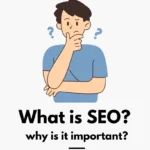- admin
- Introduction to SEO
- 0 Comments
- 105 Views
Search Engine Optimization (SEO) began in the mid-1990s when webmasters and content providers began optimizing sites for search engines. Initially, this involved submitting URLs to search engines for indexing.
Over time, SEO evolved with the development of algorithms by search engines like Google to provide more relevant search results.
The focus shifted from keyword stuffing to creating high-quality content and improving user experience. Today, SEO involves various strategies including on-page optimization, link building, and technical SEO to ensure websites rank well on search engine results pages (SERPs).
The ultimate goal is to drive organic traffic to websites by improving their visibility and relevance in search results.
What Are the Trends in SEO Over Time?
SEO trends have evolved significantly over the years, driven by changes in search engine algorithms, user behavior, and technology. Here’s a detailed look at the key trends, challenges, and solutions over the years:
1990s: The Birth of SEO
- Trend: Early SEO focused on basic on-page optimization like meta tags, keyword stuffing, and submitting URLs to search engines.
- Challenges: Limited search engine capabilities, simple algorithms easily manipulated by keyword stuffing.
- Solutions: Basic optimization tactics, such as using relevant keywords in meta tags and content.
2000s: The Rise of Google
- Trend: Google introduced PageRank, emphasizing backlinks as a ranking factor.
- Challenges: Black hat SEO tactics like link farms and spammy backlinks became rampant.
- Solutions: Development of ethical link-building strategies and creating valuable content to earn natural backlinks.
2010-2012: Content is King
- Trend: Google’s Panda and Penguin updates aimed to penalize low-quality content and manipulative link practices.
- Challenges: Websites with thin content and poor user experience were de-ranked.
- Solutions: Focus shifted to creating high-quality, user-focused content and ethical SEO practices.
2013-2015: The Mobile Revolution
- Trend: Mobile optimization became crucial with the rise of smartphone usage and Google’s mobile-friendly update.
- Challenges: Websites not optimized for mobile faced ranking penalties.
- Solutions: Adoption of responsive web design and improving mobile user experience.
2016-2018: Voice Search and AI
- Trend: Growth in voice search and the use of AI, such as Google’s RankBrain, changed the SEO landscape.
- Challenges: Traditional keyword strategies became less effective; need to optimize for natural language queries.
- Solutions: Creating content that answers questions directly and optimizing for conversational search terms.
2019-2021: E-A-T and Core Web Vitals
- Trend: Emphasis on Expertise, Authoritativeness, and Trustworthiness (E-A-T) and page experience metrics through Core Web Vitals.
- Challenges: Ensuring content and websites meet Google’s E-A-T standards and optimizing for page speed, interactivity, and visual stability.
- Solutions: Building authoritative content, improving site performance, and enhancing overall user experience.
2022-Present: User Intent and AI-Driven SEO
- Trend: Increasing importance of understanding user intent and leveraging AI tools for SEO.
- Challenges: Keeping up with rapid algorithm changes and integrating AI effectively.
- Solutions: Utilizing AI-driven SEO tools, focusing on user intent, and continuous content optimization.
Over the years, the primary goal of SEO has remained the same: to improve website visibility and drive organic traffic. However, the strategies and tactics have evolved significantly to adapt to technological advancements and changing search engine algorithms.
Is There an Opportunity for Small Businesses to Win with SEO?
Yes, small businesses can absolutely succeed with SEO. The key lies in leveraging local SEO strategies, creating high-quality content, and building a strong online presence. Here’s a closer look:
Small businesses can compete effectively with larger companies in SEO by focusing on niche markets and local search optimization. Unlike big corporations, small businesses can be more agile and target specific local areas or niche keywords.
This helps in driving more relevant and engaged traffic to their websites. Moreover, with the right strategies like optimizing for local searches, building strong local citations, and encouraging customer reviews, small businesses can enhance their visibility in local search results.
Consistent, high-quality content creation and a well-optimized website can further boost their SEO efforts, helping them to stand out in search engine rankings.
By focusing on these areas, small businesses can attract more customers, increase their online presence, and ultimately grow their business through effective SEO practices.




